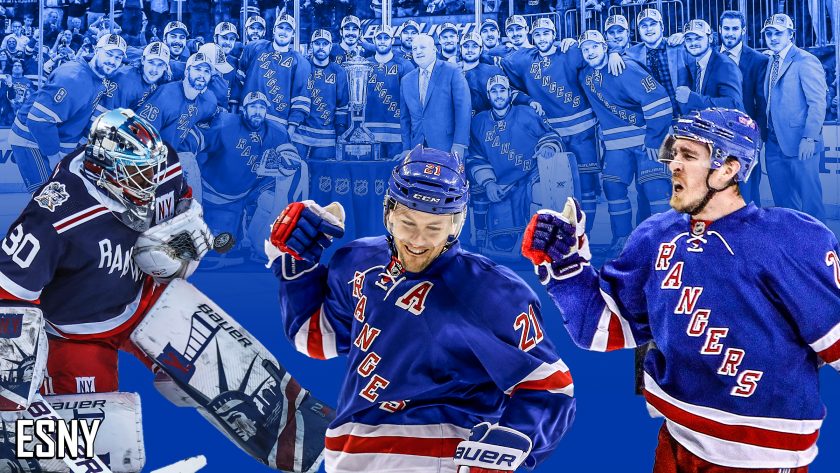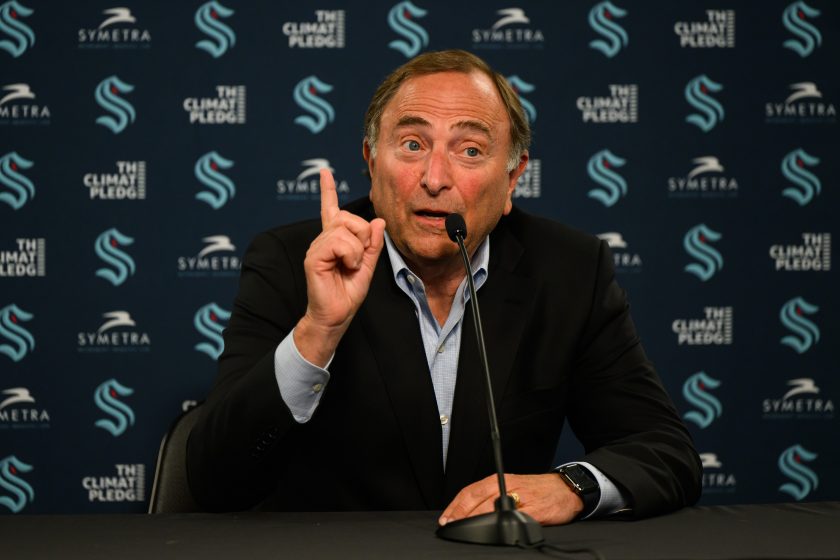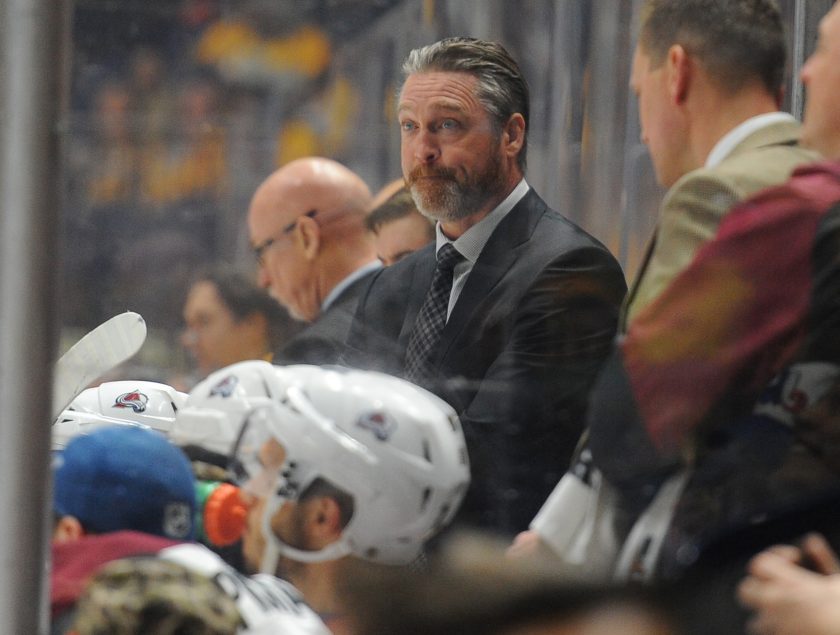ESNY’s New York Rangers all-decade team (2010-2019)

ESNY’s New York Rangers all-decade team presents a strong club headlined by all-time great Henrik Lundqvist.
[sc name=”Dom Renna Banner”]Ten years have come and gone, and the New York Rangers still find themselves in the same position they were before the decade began: without a championship.
Nonetheless, there were plenty of highs throughout the 2010s a time that saw the Rangers compete for the Stanley Cup every year while arguably becoming the best team in the NHL at the time. While that was at the midway point of the decade, it helped usher in a sense of hope to a fanbase needed something to convince them they would go four decades without a championship like they had to endure from 1954 up until 1994.
Unfortunately, though, the Rangers could not get to the promised land and now find themselves in rebuilding mode, which has seen fan-favorites come and go—something that caught everyone from players to fans off-guard.
Even with all of the change, it wasn’t a wasted decade. The players listed below all helped play a major role in reaching that conclusion and it all leads up to the question of what could have been when looking at the great talent this Rangers team acquired over the last 10 years.
The decisions that went into assembling this roster were based on performance, character, leadership and pure skill.
[sc name=”The Bread Man T-Shirt” ]First Line: Artemi Panarin-Mika Zibanejad-Marian Gaborik
Despite being acquired prior to the last three months of the decade, Artemi Panarin has already established himself as the best forward the Rangers could possibly put on the ice. He’s already done things fans have not seen a Ranger do in quite some time, and it’s safe to say that if New York had a player of his caliber on their roster during their Cup runs in 2014 and 2015, things might have been a little different. He was the spark they needed, but couldn’t find, and they hope his talent will help lead them to a championship at some point during the next decade.
The Mika Zibanejad trade might go down as one of the best trades the Rangers made throughout the decade. They took a declining player in Derick Brassard and turned him into one of the best centers in the NHL, Zibanejad. Initially, the trade didn’t look like it would work in the Rangers’ favor. Initially, Mika was still a young up-and-coming player, but he’s turned himself into a superstar.

Going with Marian Gaborik on the first line might come across as a reach, but when considering his filthy talents, it would be foolish not to throw him on that first line. Gaborik scored 114 goals in his four years with New York while tallying 229 points in that span. The only reason his time Broadway did not work was the fact that he did not fit in under head coach John Tortorella’s scheme at the time.
Second Line: Rick Nash-Derek Stepan-Mats Zuccarello
The Rick Nash trade was the trade that was supposed to put the Rangers over the top after a competitive Stanley Cup run that ultimately fell short at the end of the 2011-12 campaign.
Throughout his time with New York, Nash showed he was so much more than just a power forward and that his all-around game was extremely underrated. While most fans were critical of his postseason play, his time in New York did not disappoint. He scored 145 goals in New York, including a 42-goal campaign in 2014-15, along with four 20-goal seasons. If not for Panarin’s emergence, he could have easily found himself on the top line for this piece.
Derek Stepan grew as right before our very own eyes throughout the decade. After his hat-trick vs. Buffalo in his first game, Stepan grew into the number one center role on the two Cup contending teams in 2014 and 2015. He was one of the most important Rangers of the decade, and he scored one of the most important goals of the decade in Game 7 of the 2015 Eastern Conference Semifinals.

While Stepan was the first piece to fall in the Rangers rebuild, none of the success they saw in the decade would have been possible without him anchoring the top line, the power-play and the Rangers penalty kill.
It would have been foolish to leave Mats Zuccarello outside of the top-six forward group considering all he did in his time with the Rangers. A player whose Rangers career began with questions of ability turned into a player who fans would really rally behind and supported like no other player the decade had to offer. Throughout his time with New York, he predominantly played on the first line, but for a piece like this and the talent at the organization’s disposal, the second line is where he fits best.
Third Line: Chris Kreider-Derick Brassard-Kevin Hayes
When thinking about the bottom six for the Rangers in this piece, there were some extremely hard decisions to be made. It would be extremely difficult to leave a player of Kevin Hayes’s caliber off this roster due to his position so moving him to the wing was the next best option.
Now, while Hayes never played wing for the Rangers, his skill set fits well to play along with the likes of Chirs Kreider and Derick Brassard. His ability to create plays out of nothing to go along with how he can hold onto the puck in order to create plays might go down as the best Blueshirts have seen in some time. He was a player who became a solid two way player for the Blueshirts while playing an imperative role during the post-Stepan era.
Brassard’s time on Broadway has to go down as an overwhelming success. After his flashy debut following an April 3, 2013 trade, Brassard became an integral part of the Rangers two Stanley Cup playoff runs in 2014 and 2015 as the club’s second-line center. He always came up big in the clutch scoring 44 points in 59 playoff games, 18 goals, including a hat-trick in the 2015 Eastern Conference Finals. His departure stung, but it was time for a change and it worked out for the Rangers in the long-haul.

While Chris Kreider has been battling through a down year in 2019-20, nobody can deny the importance he brought to the Rangers during the 2010s. After an electrifying NHL debut during the playoffs, he became a mainstay in the Blueshirts’ lineup as a player and a leader. No matter what happens with Kreider and his contract situation in 2019-20, New York did not make a mistake using the 19th overall pick on him in 2009.
Fourth Line: Jesper Fast-Brian Boyle-Carl Hagelin
Jesper Fast’s emergence towards the end of the decade makes him one of the more underrated players in the NHL. He’s a coach’s dream player and it’s shown over the last three seasons while he plays up and down the Rangers lineup. If a predominant offensively-minded line needed some defense, Fast was there to fill in. When his team takes a penalty near the end of the period, Fast is usually part of the first wave of penalty-killers on the ice. He’s played a big role for the Rangers the last 10 years and deserves to be on a list like this.
Brian Boyle‘s importance to the Rangers was big considering he could play a variety of different situations. He established career highs in goals and assists while wearing a Blueshirt and his departure in 2014-15 hurt the Rangers moving forward. His game best suits to be a bottom-six guy, and he’s the perfect player to center a piece like this.

When the Rangers made the coaching change from John Tortorella to Alain Vigneault, the importance of Hagelin became clearer than ever. During his time with New York, his speed was game-changing and his penalty-killing prowess was spectacular. While he was never the type of player who was going to score 20-plus goals, you knew what you were getting with him, making him one of the most important players the decade had to offer the Rangers.
First Defensive Pairing: Ryan McDonagh-Dan Girardi
There is no denying it, the pairing of Ryan McDonagh and Dan Girardi served as the Rangers anchor throughout their playoff runs the last 10 years.
The Rangers practically stole McDonagh in a trade with the Montreal Canadiens and he quickly became the Rangers best defenseman and a future captain. While paired with Girardi for the most of his Ranger tenure, McDonagh displayed a skill level New York desperately needed on the blue line in an evolving NHL.

With McDonagh taking care of the offensive side of things for the Rangers’ blue line, Girardi served as a staple defensively being there to bail out his partner when he needed it. Girardi became known as a warrior after the Rangers signed him as an undrafted free agent. Every night, he gave his all on the ice, including giving up his body to block a shot. While the tail end of his career he wasn’t the same player he once was, without him the Rangers do not accomplish any of what they did.
Second Defensive Pairing: Marc Staal-Keith Yandle
Admittedly, this might be the first reach of this entire piece considering the mixed feelings Ranger fans have for Keith Yandle.
One crucially important detail to remember about Yandle’s time as a Ranger was the mismanagement of his ice time and putting him spots where he was more likely to fail rather than succeed. Taking those in mind, what Yandle did with the Rangers was quite impressive—scoring 58 points in 103 games. Who knows what could have been if he had more time in New York, but over his New York sample size, he did what he was asked to do.
Currently, Marc Staal finds himself in the same boat Girardi did towards the end of his career. While his play at times warrants the criticism when building a list like this, he has to be involved.
Before the arrival of McDonagh, Staal was the man paired with Girardi on the Rangers No. 1 defensive pairing where he played key minutes for the Blueshirts. Unfortunately for him, he suffered some freak injuries that altered his game from what it was earlier in the decade to what we’ve seen lately. Nevertheless, it’s important to remember it wasn’t all bad for Staal on Broadway.

Third Defensive Pairing: Kevin Klein-Anton Stralman
There haven’t been two players (that weren’t superstars) who altered the Rangers blueline like Anton Stralman and Kevin Klein.
Stralman was one of the more underrated players the Rangers deployed on the blue line. A guy who, much like Zuccarello, proved his worth on the ice the more he played. He was never a shutdown defender, but he was consistent enough to be a part of the Rangers’ top four. It’s safe to say New York never really felt the importance of Stralman until after his departure following the 2013-14 season, which would ultimately lead to the Yandle acquisition.
The addition of Klein to New York’s backend will go down as one of the best trades Glen Sather pulled off in his time with the Rangers. While Klein was a guy most people had to do a quick Google search for after they acquired him, he became a key piece of the Rangers defense core. Swapping Michael Del Zotto out for Klein changed the trajectory of this team and it’s safe to say New York does not make it to the Stanley Cup Final without his defensive steadiness.
Starting Goaltender: Henrik Lundqvist
Was it ever really a question? The most important piece to all of the success the Rangers found from 2010-2019 goes through the crease and Henrik Lundqvist, the backbone of the franchise well before 2010.
When it’s all said and done, Lundqvist will go down as the greatest goaltender in Rangers’ history, even if he doesn’t bring home a Cup. Without his play in goal, New York, without a doubt, does not make it out of the 2014 Eastern Conference Semifinals vs. Pittsburgh. That would be the first of two times Lundqvist help carry New York past a 3-1 deficit and one of the many impressive accomplishments headlining his resume.

Entering play Sunday afternoon, Lundqvist leads the Rangers in almost every category a goaltender can lead in with 456 wins, 23,300 saves, 51,314 minutes, 63 shutouts, and he is closing in on the top five in games played as a Ranger.
Backup Goaltender: Cam Talbot
The Rangers have seen some quality backup goaltenders who have become starters in the league over the last 10 years, but none of them stand out as much as Cam Talbot did.
After he burst onto the scene in 2013-14 following the retirement of Martin Biron, Talbot showed he was capable of big things. Every night, the Rangers knew they had a chance to win with him or Lundqvist in between the pipes, and that is all you can ever ask from your goaltenders.

Talbot’s biggest impact on the Rangers in his two years with the club came in the 2014-15 season when he had to fill in for an injured Lundqvist to close the season. He would make 34 starts that year, posting a 21-9-4 record while the Rangers didn’t miss a beat following what could have been a disastrous injury to their franchise player. While he lost the starting job after Lundqvist’s return, the Rangers do not make the playoffs without Talbot in 2015.
Head Coach: Alain Vigneault
As frustrating as the end of Alain Vigneault’s tenure with the Rangers was, most of the Rangers’ accomplishments over the last decade came with Vigneault behind the bench.
AV was brought in to be the anti-John Tortorella and he was just that with a more up-pace tempo system that developed the Rangers into one of the better offensive teams in the league. Mats Zuccarello, Derek Stepan, Kevin Hayes, Chris Kreider, Ryan McDonagh and Brady Skjei all flourished under Vigneault.
Vigneault finished his tenure third in franchise history in wins (226), points percentage (.596) and postseason wins (31). He led New York to back-to-back trips to the Eastern Conference Final, along with a Presidents’ Trophy, and the club’s first Stanley Cup appearance since 1994.
Honorable Mentions
- J.T. Miller
- Dominic Moore
- John Tortorella
- Ryan Callahan
Dominick is a graduate of Canisius College. He has covered the Rangers for the last seven seasons and the Yankees for the last four.






